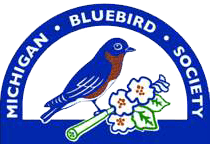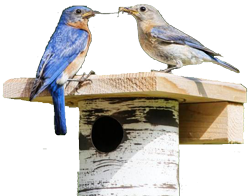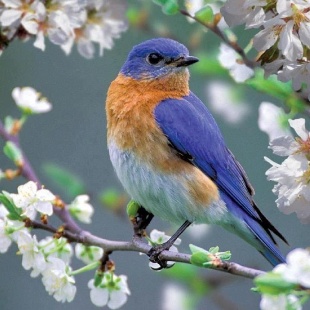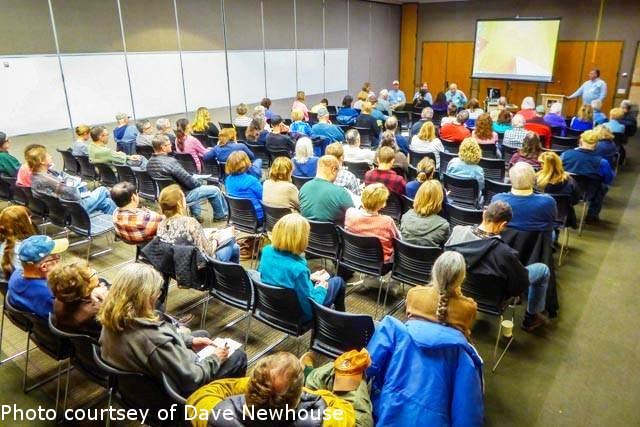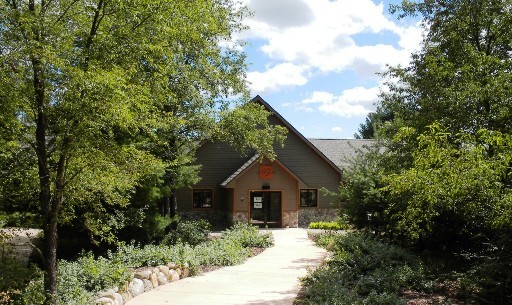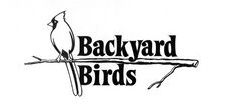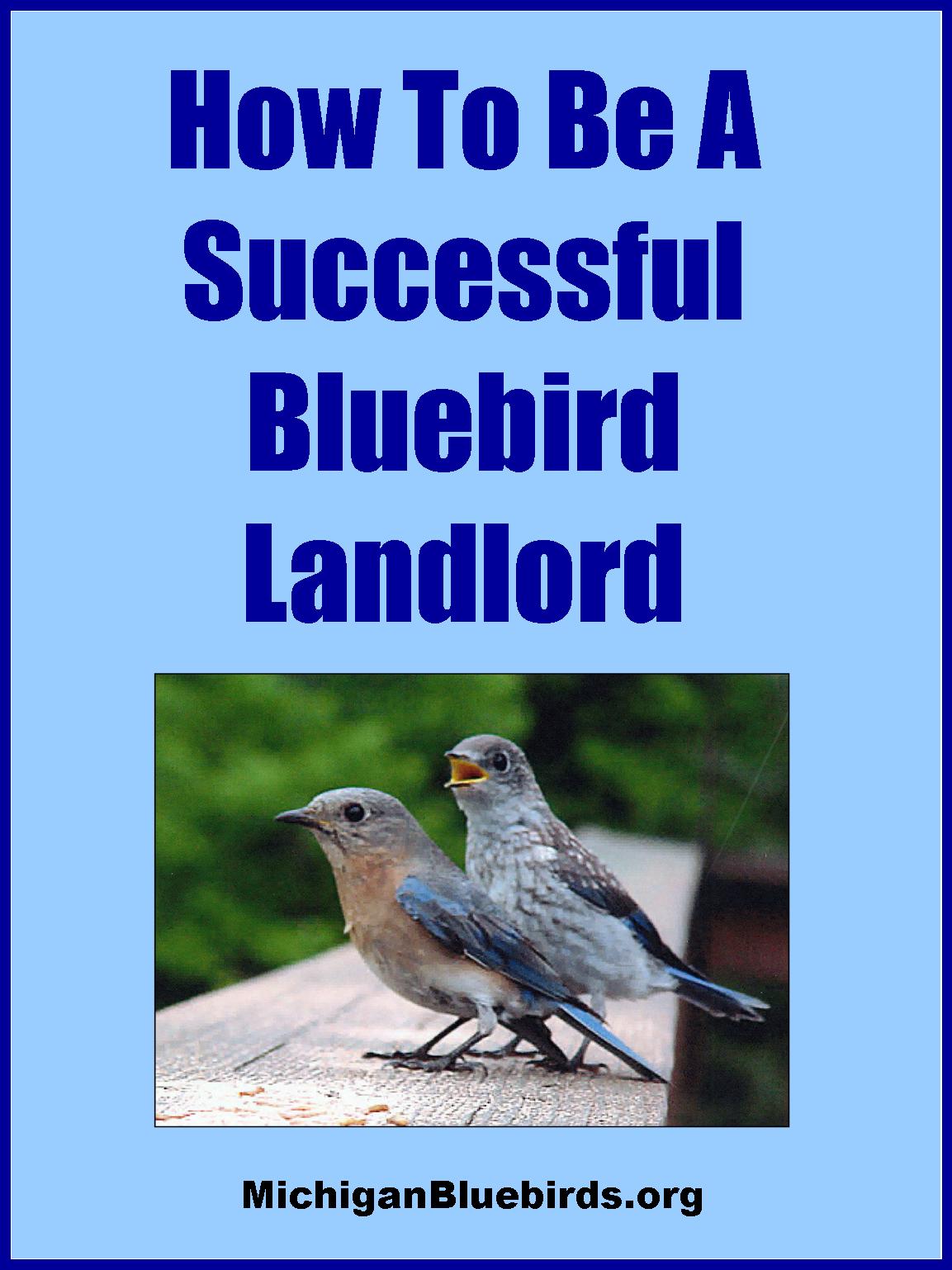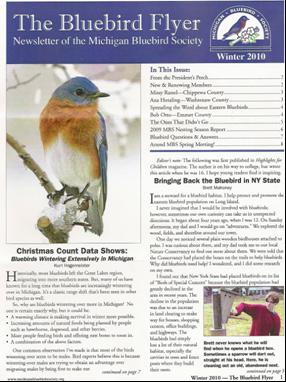Below are answers to Frequently Asked Questions, which MBS receives....
Q. Do bluebirds roost singly or in a group during cold weather?
A. They can do both. It depends on the size of the cavity to some degree. But since bluebirds travel in small groups during the fall and winter, it’s very common to find a number of them roosting in a tree cavity or bluebird box left outside.
Q. Can I save a bluebird nest I found in one of my boxes?
A. According to wildlife laws, it’s illegal to keep feathers, nests, or entire bird specimens without a license. Sometimes, it’s useful to keep old nests to be used in replacing a very wet or parasite filled nest. But in order to stay on the good side of the law, it’s best to just fashion a nest yourself, made of dry grasses.
Q. Can bluebird houses be left outside in winter so bluebirds will roost in them?
A.Yes, you can leave out bluebird boxes in winter to be used as roosting houses. However, a couple steps should be taken to optimize their use by the bluebirds. First, plug up any ventilation openings or holes with weather stripping or removable caulking to keep cold air out. Second, if possible, remove and “flip” the orientation of the house front so the entrance hole is at the bottom. Third, drill several staggered, shallow holes of ¼” diameter on the inside walls and caulk in-place some 2” long ¼” wooden dowels for perches. This will help multiple bluebirds roost in the box.
Q. Is there such thing as a “bluebird feeder”?
A. Bluebirds will feed at almost any type of feeder that has food they’re interested in, even tube feeders. However, tray feeders containing meal worms or special suet/raisin/cornmeal mixes work very well. There is another special type of feeder designed specifically for bluebirds that is basically a wooden hopper feeder with closed glass fronts, and 1 ½” entrance holes drilled on each end. This enables the birds to enter the feeder to get the food. See our Feeding Bluebirds page for a picture.
Q. What type of natural foods do bluebirds eat in the winter?
A. A bluebird’s diet shifts to eating berries during winter, since their warm weather insect food is not available. This also helps bluebirds survive if they DO migrate and return to northern nesting areas in late winter. Many berries gradually become more edible as the winter progresses. Here are common bluebird berries: dogwood, holly, juniper, sumac, mountain ash, mistletoe, hack berry, multiflora rose, and viburnum (Note: some of these are non-native species).
Q. Is there a recipe for bluebird food I can put out in winter?
A. Yes. Here is a very popular recipe called Bluebird Banquet (from The Bluebird Monitor’s Guide).
Mix: 1 cup peanut butter, 4 cups yellow cornmeal, 1 cup unbleached white or whole-wheat flour in a mixing bowl.
Add: 1 cup fine sunflower chips, 1 cup grated peanuts, 1/2 to 1 cup currants (or softened raisins—can be done by soaking in water).
Drizzle and stir in: 1 cup melted rendered suet (try to get kidney suet as it’s easier to melt).
When the mixture cools, it should have a crumbly texture. If not, add more flour or melted suet if necessary. Refrigerate: Then present to bluebirds in an open tray feeder or enclosed bluebird feeder.
Q. How long does it take for bluebirds to build their nest?
A. From 2-6 days. Keep in mind, poor weather can delay things.
Q. I have an annoying House Sparrow pair chasing my bluebirds away from the nestbox. Is there anything I can do?
A. Unfortunately, there’s no simple solution that works every time. But, here are some things that can be effective: First, keep removing the sparrow nest as soon as it builds a new one. This can be every 1-2 days. If you are persistent, the sparrows might go away eventually. Second, consider trapping the sparrows and either euthanizing them or removing them from the area physically. There are cage type traps or in-box traps available. Third, open up the box and leave it that way for several days. The sparrow might move on. Finally, there is a commercial product called a magic halo to attach to the box that has had some success. See the article in the Spring 2008 Issue of The Flyer, or our Solving Problems page.
Q. How late in the year will bluebirds nest in Michigan?
A. Bluebirds can still fledge in Michigan as late as mid-August, depending on the weather and food availability. Further north, such as the Upper Peninsula, this last fledging date could be 1 to 2 weeks earlier.
Q. Will bluebirds that fledge in summer stay around into fall?
A. Often they will, but bluebirds will move around over a much larger area in search of food. As the weather gets cooler, insect numbers decline quickly. This forces bluebirds to look harder over a greater area AND shift to eating more ripening berries. Also, you’ll tend to notice bluebirds gathering in larger flocks in Autumn. Some will migrate further south while others will winter over..
Q. I sometimes see flocks of bluebirds in my area in the fall. What do they eat this time of year?
A. During the fall, a bluebird’s diet shifts from insects to mainly berries and some seeds that ripen this time of year. Examples include sumac, chokecherry, pokeweed, hawthorn, and mountain ash. For a larger list of preferred wild berries, see our Planting for Bluebirds page. You can also feed them meal worms, which they readily eat any time of the year.
Q. Do Bluebirds leave Michigan in the Fall?
A. Not completely. They WILL migrate south, out of the upper peninsula and northern 2/3 of the state (approximately). But, bluebirds commonly remain in large numbers all winter in the southern part of the lower peninsula. This may be due to milder weather in recent years and greater food availability. Things you can do to help them include feeding mealworms, leaving out several nest boxes for them to roost in, and providing a heated birdbath or water source.
Q. Sometimes in winter on mild, sunny days, I’ll see a bluebird sitting on a nesting box that I left outside. Isn’t that too early for them to start nesting?
A. Mild weather in late January or February can sometimes “fool” bluebirds into thinking spring is almost here. That can bring out their instinct to start finding and defending nesting territories. But, don’t worry. Once the weather gets colder again, bluebirds will resume their winter routines and stop sitting on the nest box. Then, when March gets here and the weather gets milder, daylight increases, and food starts to become available, bluebirds will establish nesting territories.
Q. Can regular bluebird nest boxes be used for roosting boxes in the winter?
A. Yes. You can leave out a nesting box for bluebirds to spend cold winter nights in. If you do, it’s a good idea to seal any ventilation slots or holes with weather stripping or removable caulk in order to keep out cold air and snow. Also, if possible, orient the nest box entrance hole away from the north and northwest where prevailing winter winds come from. Another idea is to build a specific bluebird roosting box. For details, go to: www.sialis.org/roost.htm. (Click on Woodworking for Wildlife)
Q. I saw bluebirds going into my nest box earlier in the spring, and they started to build a nest. But I haven’t seen them since. What is going on? Should I take out the nesting material?
A. It’s hard to say what happened to your bluebirds. Sometimes they may not develop a strong enough bond to the territory early in the season and have simply moved on. Or it’s possible that something happened to one of the two birds. Finally, something may have spooked them from nesting there (for example, a predator trying to get into the box). So, at this point, they probably will not nest in the box. Leaving the old nesting material in the box probably won’t make any difference to a new pair of birds. Let them decide whether to use it or discard it..
Q. Are any nest box designs less attractive to house sparrows?
A. First realize that despite lots of research, no nesting box design has been determined to deter all house sparrows in all cases. But, more recent research has been pointing to the fact that boxes with smaller nesting spaces in them seem to be less desirable to sparrows. In particular, the PVC Gilbertson nest box, Troyer nest box, and Gilwood designs have gotten encouraging results. See our page on bluebird nesting boxes for more information on these designs. You also can download plans for bluebird houses to build your own modified Gilwood house or Troyer box.
Q. I keep seeing a group of bluebirds in the yard. How can I tell which ones are juveniles and which are adult birds?
A. Without exception, young bluebirds have spotting on the breast and underside, and also on the back. They also have a lot less blue than the adults. However, young bluebirds go through a feather molt in mid to late summer where they then lose the spotted feathers and gain their adult plumage. By fall, it will be difficult if not impossible to tell the difference between the younger and older birds.
Q. I haven’t seen bluebirds in my yard for weeks now. When do they start migrating south?
A. Bluebirds will often join together in small groups or flocks in late summer and fall, searching for food. In doing so, they will move over larger distances and may disappear from your area for long periods of time. However, many bluebirds winter over in Michigan – especially in the lower half of the lower peninsula. Those that DO migrate will often leave in October & November, and journey to wintering grounds further south in states in the eastern U.S.
Q. I want to build some nesting boxes for bluebirds during the winter months. What is the best type of wood to use?
A. Western Red Cedar is considered by many bluebirders to be the best wood for nest boxes. It is highly insect and rot resistant outdoors, and usually is milled with one rough side. The rough side is best used on the exterior of the box and helps bluebirds cling to it more easily. A downside is that cedar is about 60% more expensive than pine. You can use aromatic Eastern Red Cedar, but it is not carried by as many lumber stores and often does not come with a rough side. But white cedar is good too if your lumber yard carries it. White pine is the most economical wood to use, but does not last as long outside. It does not typically come with a rough side either. In all cases, you should use ¾” thick wood and roughen the interior surface of the house front below the entrance hole to enable the young and adults to climb out more easily.
Q. Do bluebirds “sing” in the fall and winter?
A. Bluebirds will definitely vocalize year-round. However, during the fall and winter, you are less likely to hear their “full-blown” song used by the males while establishing a nesting territory. What you are likely to hear are somewhat softer, shorter portions of their song used as calls to stay in contact with the small flocks bluebirds are found in this time of year. This can sound something like “cheer-cheer-churchur” made with low-pitched melodious whistles.
Q. I’m building some nesting boxes this winter and would like to know if I should stain them?
A. There is a healthy debate on this topic in the bluebird community. First, know that bluebirds will readily choose BOTH stained and unstained boxes. Staining the exterior of the box can help it last much longer by reducing moisture penetration into the wood. But, there is some evidence now that bluebirds may actually prefer boxes with stained interiors. The idea here may be that the darker interior seems more like an actual tree cavity. There needs to be more research on this topic. If you DO choose to stain the box, use a non-toxic stain and allow the box to dry very thoroughly before putting it outside. (See our Spring 2011 issue for a full article on nest box staining.)
Q. Is it true that bluebirds are easily attracted to birdbaths?
A. Yes! Bluebirds are members of the thrush family (as are robins) and birds in this group seem to love to bathe and drink water in bird baths. You should provide a bird bath with shallow sloping sides and a rough surface to make it safer and easier for birds to enter the water. Also, place birdbaths away from low ground cover and shrubs where cats can lurk. And water can still be put out in the winter using a heated birdbath.
Q. What is the best way to prevent blowfly infestations in my nest box?
A. First, it is critically important when doing nest checks, to look for evidence of blowflies. You can do this by looking under the nest for the grayish, brown oval shaped larvae that feed on the young birds. Sweep them out of the box and make sure there are none attached to the young. Extremely wet nests encourage the blowflies and need to be replaced with dry grass in some cases. For prevention, suspending the nest slightly above the wood floor by putting a ½” hardware cloth “riser” in the nest box before nest building will help keep the nest free of blowflies.
Q. What’s the best direction for the front of the bluebird box to face when you put it up outside?
A. There’s a lot of debate about this subject with no definitive research that proves the bluebirds prefer a box facing one direction or another. Conventional thinking is that it should face away from the west or northwest where prevailing storms come from. Theoretically, this would help reduce rainwater getting into the box. However, a well-designed, tight nest box with a good roof overhang would largely prevent this problem. The best advice is to face the box so you can easily see the entrance from a distance. This will improve your ability to monitor what’s going on and add to your enjoyment of watching the nesting process.
Q. When doing a nest check, I found an unhatched egg with the four day old chicks. What should I do about it??
A. If the egg is unhatched after 4 days, it’s almost certainly infertile and will not hatch. You will need to remove it from the nest and dispose of it a distance away from the box. If the egg were to remain in the box, the odds are high it would eventually break. The resulting rotting odors could attract predators and harmful insects to the nest.
Q. Is it better to use a bluebird box with a larger cavity size
(deeper and bigger floor) or is a smaller space preferred?
A. Bluebirds will nest in most sized nesting boxes when it comes down to it. Usually, the location and habitat quality will be more important than the size of the box or entrance hole type. However, recent research has been showing that all else being equal, the bluebirds prefer a shallower, smaller cavity-size box. Examples of these would be the Gilbertson PVC box, Gilwood, Troyer, and Peterson styles. Why is this? We don’t know for sure, but these boxes may better emulate the smaller natural cavities bluebirds often find in say, apple trees. Also, it’s believed that house sparrows don’t like the shallower boxes as much.
